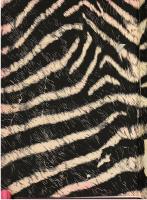Equatorial Guinea - the Forgotten Dictatorship: Forced Labour and Political Murder in Central Africa 0900918055, 9780900918056
270 102 3MB
English Pages 43 [46] Year 1976
Introduction 5
1. History 7
The Colonial past 7
Equatorial Guinea since Independence 13
2. Repression 15
Forced labour 15
Freedom and religion 19
Torture and murder 21
Refugees 25
President Macias’ reply 27
3. Foreign Silence 30
Spain 31
France 33
United States 35
Switzerland and other European Countries 37
China 37
USSR 38
Cuba 38
United Nations agencies 39
Conclusion 42
Recommend Papers
File loading please wait...
Citation preview
/¥quatorial Guinea -
the forgotten dictatorship / Forced labour and political murder in Central Africa
Suzanne Cronjé
Research Report No 2 Anti-Slavery Society
1477
©1976 Suzanne Cronjé Published by Anti-Slavery Society 60 Weymouth Street London W1N 4DX Printed by the Trade Printing Company Typeset by Jetset ISBN 0 900918 05 5
Suzanne Cronjé writes on African affairs. Her publications include: Witness in the Dark (police torture in South Africa), Christian Action 1964; Biafra,
Britain’s Shame (with Auberon Waugh), Michael Joseph 1969; The World and Nigeria — a diplomatic history of the Biafran war 1967-1970 Sidgwick and Jackson 1972; Lonrho, Portrait of a Multinational (with Margaret Ling and
Gillian Cronjé), Julian Friedman and Penguin 1976. Research Report No. 1 Western Sahara; The Fight for Self-determination by John Gretton 1976 is available from the Anti-Slavery Society price 75p.
a
BE adit aesais cate aerate eaeenaeHTS a ION iereree eS UR tahae eeNENG ettererseSteP, AEGPREREN PeuPRT ENeee caries atk Lee eeete ee, SPE
Contents
Introduction
5
1 History 7 The Colonial past 7 Equatorial Guinea since Independence 2 Repression
15
Forced labour
15
Freedom and religion Torture and murder
Refugees
19 21
25
President Macias’ reply 3 Foreign Silence
Spain
13
27
30
31
France 33 United States 35 Switzerland and other European Countries China 37 USSR 38 Cuba
38
United Nations agencies Conclusion
42
39
37
EEO
Introduction
Few people outside Africa have heard of Equatorial Guinea. Those who have, vaguely recall that some notoriety attaches to it, but they tend to confuse Equatorial Guinea with the Republic of Guinea, a former French colony which is also known as Guinea-Conakry, to differentiate it from its newly independent neighbour, Guinea-Bissau, until recently ruled by the Portuguese. Guinea-Conakry and Guinea-Bissau are on Africa’s north-western shoulder, where the continent bulges into the Atlantic Ocean. Equatorial Guinea, as its name implies, is near the equator much further south, in the
Gulf of Guinea. The country consists of two parts: Rio Muni, an enclave on the African mainland some 10,040 square miles in area, and the island of Fernando Po,
now renamed the island of Macias Nguema Biyogo after the President, which is some 785 square miles in extent. The total population in 1969 was 286,000, but as up to a quarter of the citizens are now said to be in exile the
actual number of inhabitants at present may be considerably smaller. Cocoa has been the main cash export, but with political uncertainties and consequent economic mismanagement exports of this commodity have seriously fallen of late, and no other economic activity seems to have taken its place. At independence in 1968 the per capita gross national product was about $260, not inconsiderable by African standards, but recently the World
Bank noted a decline in GNP of 3.1 per cent over the period 1965-73. Communications with the outside world are so bad as to be almost nonexistent: certainly the government has not been anxious to spread information about the state of affairs in this potentially prosperous country. Equatorial Guinea’s main trading partner, Spain, connives at this silence about its former colony. In August 1976 the Spanish law making news about Equatorial Guinea classified material was extended for a further six months;
the regulations cover all news reports, commentaries and dispatches which can be published by Spanish news media. In August 1976 the United Nations Sub-Commission on the Prevention of Discrimination and Protection of Minorities decided, on grounds of gross and persistent violation of human rights, to examine conditions in Equatorial Guinea. The situation in that country which has given rise to this UN decision is examined in the following chapters.
|
|
EQUATORIAL COMPRISING
RIO MUNI
GUINEA
AND
MACIAS
w"s
Sy, w2
CNA
4
Lake
Loe
N\wiceria
f3
a \
“E
(
(
Chad
7s
Volt \ MACIAS NGUEMAO\



![Equatorial Guinea (Bradt Travel Guides) [1 ed.]](https://ebin.pub/img/200x200/equatorial-guinea-bradt-travel-guides-1nbsped.jpg)






